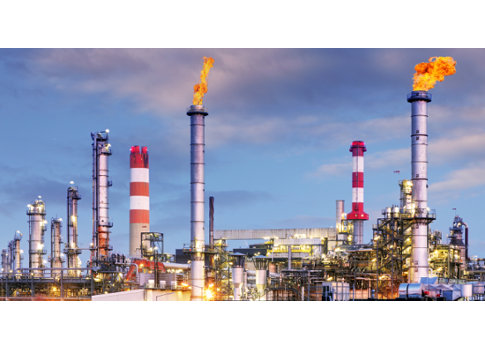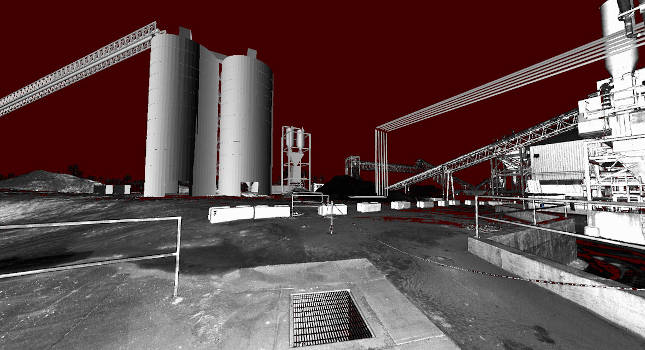Just as the process piping and controls for a flare need to be properly designed to handle the full range of product flow rates to the flare, the steam supplied to the flare needs equal consideration.

Flares are a common site in petrochemical plants. They are used to safely incinerate products that need to be disposed. Ideally the load on a flare should be very light. However, there are times where there is a large amount of product that cannot be stored and incineration is the most practical solution. High loads on flares will normally occur during an upset condition such as a safety valve opening or a unit being out of service that would normally process the product being sent to the flare.
When incinerating these products, combustion efficiency is of paramount importance, as well as the avoidance of "smoking" or releasing carbon that can be seen. To accomplish both of these goals, flares often use steam or air for the flaring process.
Due to the nature of flares being a safe way of disposing large quantities of product when there is a problem, the load on a flare can change from a low flow to a high flow rather quickly. While this will be a planned event at times (such as during a scheduled outage), it will oftentimes be the result of an upset condition. Regardless of the situation, the system has to be designed to handle the entire flow range.
While this system is an integral part of operating the plant safely, steam-assisted flares often do not get the attention they deserve. Steam is used at the flare to aspirate air into the combustion zone, shape the flame of the flare, cool the tip of the flare and reduce noise.
While steam can be fed to three parts of the flare (center steam, upper rim and inside tubes), they are typically regulated through a single control valve. Each part can impact the performance and reliability of the system. For optimum performance, controlling the flow of steam to the flare and supplying high quality (dry) steam is needed.
Flare control
If too much steam is allowed to flow to the flare, several detrimental things can happen. The collision above the flare tip can create a zone of higher pressure that can force the flame back down into the plenum. This internal burning can cause structural damage to the flare. Combustion efficiency in this case-the destruction of hydrocarbons-can actually be decreased by too much steam flow. Additionally, feeding too much steam to the flare is a waste of energy.
If too little steam is supplied to the flare, smoking (primarily the presence of carbon) will occur. This can be indicative of poor combustion, although smoking can occur while there is acceptable combustion efficiency. Unfortunately, smoking is something that can cause public concern around a plant and is best avoided.
Steam-flare solutions
Poor quality steam and/or improper steam mains drainage can hamper or even destroy even the best designed flares. Steam quality refers to the amount of moisture that is entrained in the steam flow. This is commonly called out with a dryness fraction that is represented as a percentage. For example, 100% quality steam has no entrained moisture whereas 90% quality steam contains 10% moisture by mass. This entrained moisture can cause erosion in the steam ring at the top of the flare, as well as at the nozzles that are designed to create target velocities for the induction of air and proper combustion mixture.
To address the steam quality, it is recommended to install a separator upstream of the steam supply control valve. Unlike a drip trap, the steam trap installed off the separator needs to be sized to handle the amount of condensate that could be knocked out of the steam flow at the maximum load. For saturated steam we typically recommend a design load of 10% of the maximum steam flow. This accounts for 90% quality steam being supplied to the separator.
Condensate collecting in the steam piping
There are multiple points where condensate can accumulate in the piping feeding a steam-assisted flare. If condensate is blown to the top of the flare, it can damage the rings and/or nozzles that are part of the flare system. The most serious consequence is typically having the pilot or flame extinguished. This can allow toxic hydrocarbons or pollutants to be discharged to atmosphere. The costs associated with this event can be high.
At a minimum, there needs to be a properly-designed drip leg and properly-sized drip trap upstream of the steam supply valve. On the high pressure side (upstream) of the valve, this trap can be tied into a condensate return line since there should always be a supply pressure.
Proper drainage needs to be assured downstream of the steam supply valve
This is where many plants make a mistake. Ideally flaring should happen only for short periods of time. A fixed bleed should allow a small flow of steam into the steam supply piping to keep it hot (as shown in small bypass line in graphic Fig 2). This will minimize the amount of steam that will condense when the steam supply valve needs to open.
Normally there will be little or no pressure downstream of the steam supply valve due to the valve being closed. The steam flowing through the orifice in the bypass to keep the steam supply hot will condense and that condensate will accumulate in any low or horizontal runs in the piping. A drip trap (ideally a float and thermostatic trap) should be installed at all low points and must flow down into an atmospheric return on the low pressure (downstream) side of the steam supply valve. A common mistake is to tie the steam trap outlet into a condensate return line. Any backpressure can keep this part of the system from draining properly.
If the condensate is to be returned from low points downstream of the steam supply control valve, then the traps should discharge to a vented receiver (with an overflow connection) that drains into a condensate return pump.
Summary
Just as the process piping and controls for a flare need to be properly designed to handle the full range of product flow rates to the flare, the steam supplied to the flare needs equal consideration. Keeping the system properly drained is paramount and will impact the performance and reliability of the steam-assisted flare.
-Mike Mabry is an area manager for Oil & Gas and Chemicals. This article was originally published in Steam News. Spirax Sarco is a CFE Media content partner.



